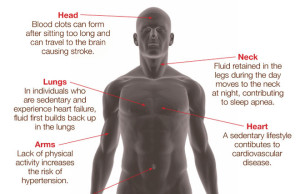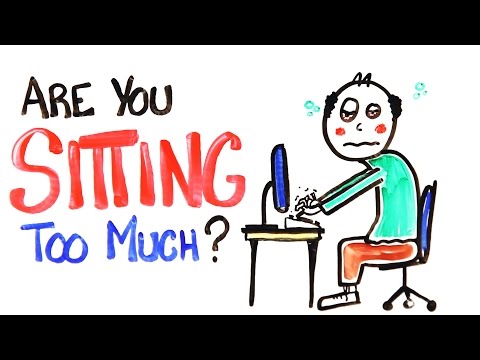Your body is designed for regular movement, but many people spend the majority of their day sitting too long.
On average, an adult spends nine to 10 hours each day sitting, which is so much inactivity that even a 30- or 60-minute workout can’t counteract its effects.
Think I’m kidding? It’s absolutely true.
As Katy Bowman, a scientist and author of the book: Move Your DNA: Restore Your Health Through Natural Movement, told Reuters:
“Actively sedentary is a new category of people who are fit for one hour but sitting around the rest of the day… You can’t offset 10 hours of stillness with one hour of exercise.”
What’s even worse, many people in the US don’t fit in a workout or a long walk either, which means their bodies are virtually always in a sedentary state. It’s not that sitting is inherently dangerous, the danger is with the duration.
While a brief period of sitting througout the day is natural, longer periods of sitting day after day at work or at home can seriously impact your health in a negative way and shorten your life span.
See What Happens to Your Body When Sitting Too Long
Dr. James Levine, co-director of the Mayo Clinic and the Arizona State University Obesity Initiative, and author of the book Get Up! Why Your Chair Is Killing You and What You Can Do About It, has dedicated a good part of his career to investigating the negative health effects of sitting too long.
Dr. Levine’s studies show that when you’ve been sitting for a long period of time and then get up, a number of molecular cascades do occur. His work showed that, within 90 seconds of standing up, the muscular and cellular systems that process blood sugar, triglycerides, and cholesterol, which are managed by insulin—are activated.
All of these molecular effects are activated simply by you walking around carrying your own bodyweight. These cellular mechanisms are also responsible for pushing fuel into your cells and, if done consistently, will dramatically decrease your risk of diabetes and obesity.
In review, at the molecular level, your body was designed to be in motion and moving all day long. When you’re sitting too long for an extended period of time, it’s like you’re telling your body it’s time to shut everything down and prepare for death.
The Mind Unleashed gave a noteworthy description of what happens in many areas of the body after sitting too long:
Negative Effects of Sitting
Organ Damage
- Heart: When you sit, blood flows like mud and muscles burn less fat, which makes it far easier for fatty acids to clog your heart. Research published in the Journal of the American College of Cardiology, for instance, showed that women who sit for 10 or more hours a day may have a significantly greater risk of developing heart disease than those who sit for five hours or less.
- Pancreas: Your body’s ability to react to insulin is affected by just one day of excess sitting, which leads your pancreas to produce increased amounts of insulin, and this may lead to diabetes and weight gai
- Colon Cancer: sitting too long may increase your risk of colon, breast, and endometrial cancers. The mechanism isn’t known for certain, but it could be due to the excessive insulin production, which encourages cell growth, or it could be the fact that constant movement boosts antioxidants in the body that may eliminate potentially cancer-causing free radicals or both.
Another reason for this increased cancer risk is thought to be linked to weight gain and associated biochemical shifts, such as changes in hormones, metabolic dysfunction, leptin dysfunction, and inflammation, all of which promote cancer.
- Digestion: Sitting down after you’ve had a meal causes your abdominal contents to compress, which slows down digestion. Slow digestion can lead to cramping, bloating, heartburn, and constipation, as well as dysbiosis in your gastrointestinal tract, a condition caused by microbial imbalances in your body. This according to Microbial Ecology in Health and Disease.
“There is growing evidence that dysbiosis of the gut microbiota is associated with the pathogenesis of both intestinal and extra-intestinal disorders. Intestinal disorders include inflammatory bowel disease, irritable bowel syndrome (IBS), and celiac disease, while extra-intestinal disorders include allergy, asthma, metabolic syndrome, cardiovascular disease, and obesity.”
Brain Damage
- Your brain function slows when your body is sedentary for too long. Your brain will get less fresh blood and oxygen, which are needed to signal for the release of brain and mood enhancing chemicals.
- Strained Neck and Shoulders: It’s common to hold your head & neck forward while working at a computer or holding a mobile phone to your ear. This can cause to strain to your cervical vertebrae along with permanent imbalances, which can lead to neck strain, sore shoulders and back.
- Back Problems: Sitting too long puts more pressure on your spine than standing, and the toll on your back health is even worse if you’re sitting hunched over in front of a computer. It’s estimated that 40 percent of people with back pain have spent long hours at their computer each day.
The vertebrae in your back are meant to expand and contract as you move, which allows them to absorb blood and nutrients. When you sit, the disks are compressed and will lose flexibility over time. Sitting too long consistently can also increase your risk of herniated disks.
Time To Stand Up and Start Moving
I believe high-intensity exercises are an essential part of a healthy lifestyle! However, the fact that more than half of men in the US, and 60 percent of women, never engage in any intense exercise lasting more than 10 minutes per week, while at the same time sitting too long daily, it’s clear that most people need to start by simply getting more non-exercise movement into their daily schedule.
It sounds so simple, right? Just get up and move. However, the reality can be harder to adapt to, since most Americans are so used to sitting while they work, eat, and watching their favorite shows. I recommend using a pedometer, or one of the newer wearable fitness trackers to monitor your progress. I’ll bet you’ll be surprised at first, to learn just how little you move around each day.
Setting a goal of say 7,000 to 10,000 steps a day (which is just over three to five miles, or 6-9 kilometers) can go a long way toward getting more movement into your life and move away from sitting too long. This should be over and above any exercise regimen you already have. Tracking your steps can also show you how simple changes to the way you move around at work can add up and keep you from sitting too long. For example, you can:
- Walk across the hall to talk to a coworker instead of sending an email
- Take the stairs instead of the elevator
- Park your car further away from the entrance
- Take a longer, roundabout way to your desk
- Set a timer for every so many minutes to get you up and moving
Bottom line, get up often from your desk and get your body moving and stay away from the negative health effects of sitting too long!
Cheers!
Source: EpigeneticsandNutrition










